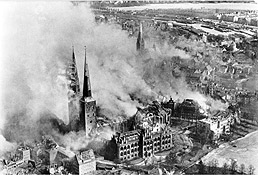Introduction
The Four Lübeck Martyrs
On the 10th of November 1943 four clergymen, the Lutheran Pastor Karl Friedrich Stellbrink and the Catholic priests Hermann Lange, Eduard Müller and Johannes Prassek were executed in the Hamburg Prison Holstenglacis by guillotining. The National-socialist "Volksgerichtshof" (People’s Court) had sentenced all four in the summer of 1943 to death because of "defeatism, malice, favouring the enemy and listening to enemy broadcasts.
Political "co-ordination" was one of the instruments of rule by the national-socialist regime: Silence, obedience, adherence to the rules were demanded categorically by the state. The four Lübeck clergymen opposed such „Allmachtsanspruch“ or all-encompassing claim of authority. They recognised the contradiction between Christian belief and the racist and atheistic ideology of the National Socialists. The recognition of this contradiction forced them not to remain mute. They did not stay on the sidelines and refrain from speaking out. The longer these injustices remained, the more they felt compelled to follow the commands of God rather than those of men, who reigned with terror and had begun a war of annihilation.
What distinguishes these four also is the fact that in the face of national-socialist despotism they overcame the divide between the two Christian denominations to find a common path to fight and act together.
They had a model to follow: The Bishop of Münster, Clemens August Graf von Galen. The four copied the sermons of the bishop and distributed them. They felt, like many others, the liberating tone of these sermons, which broke the silence and proclaimed aloud the thoughts many had in their hearts, when the Nazi action for the "destruction of unworthy lives" began, the euthanasia of innocent mentally retarded persons.
The Lübeck clergymen paid for this resistance with their lives. This sacrifice did not shorten the war, did not cause the regime to tremble. But these four are witnesses of a better world in a world of disaster and evil. They were witness to truth over lies, to dignity over contempt, witness to faith in the Lord during a time when some men brashly claimed God’s throne as their own.
With this witness, sealed by their deaths, these four Lübeck clergymen are bound together as martyrs and are there for us today to follow their example. They stood together for the Church of Jesus Christ which calls injustice by name, exposes the lie and honours the compassion of God as the spring of life.
Together they died. They knew that they were united in God’s presence; "We are brothers" said Hermann Lange. In reality they witnessed a common bond which overcame the divide. The divisions of denominations became secondary. This is what should encourage us today to follow their example of communion
in spirit, faith and action. —
The fate of the four Lübeck clergymen evolved exemplarily as a conflict between National Socialist philosophy and Christian Faith. The Four did not avoid this conflict as they attested their faith in Christ together and answered His call to united action. “Never say three, always say four!” was
something the former fellow prisoner Adolf Ehrtmann insisted upon when he was
on his deathbed in spring 1979. One of his children had wanted to give him strength by saying that he would soon be with “his” three chaplains. This motto and legacy of that man, sentenced to five years penitentiary, must be an obligation for posterity.
“Never say three, always say four!” was
something the former fellow prisoner Adolf Ehrtmann insisted upon when he was
on his deathbed in spring 1979. One of his children had wanted to give him strength by saying that he would soon be with “his” three chaplains. This motto and legacy of that man, sentenced to five years penitentiary, must be an obligation for posterity.
“Never say three, always say four!”, that is also the common legacy of the Lübeck Martyrs. The day of their death, the 10th of November, is a uniting date for both great denominations in Germany. A date is a gift, and a commission for us. The offering of the lives of Hermann Lange, Eduard Müller, Johannes Prassek and Karl Friedrich Stellbrink challenges us to also strive to commemorate the expiatory death of our Lord Jesus Christ, together to proclaim His resurrection and jointly to stand up for peace, justice and human dignity.
Original GermanText: Ökumenischer Arbeitskreis „Lübecker Märtyrer“
English Translation: Hans-Heinrich Boeker, Wyoming, Australia









